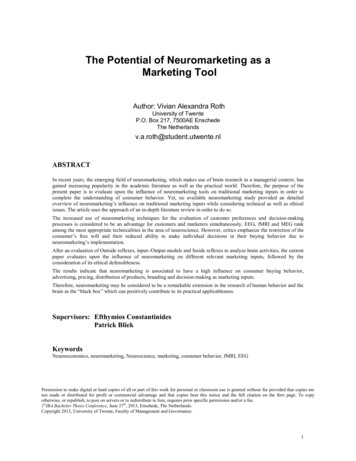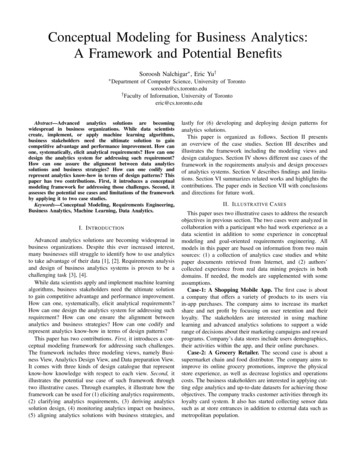
Transcription
The Potential of Neuromarketing as aMarketing ToolAuthor: Vivian Alexandra RothUniversity of TwenteP.O. Box 217, 7500AE EnschedeThe Netherlandsv.a.roth@student.utwente.nlABSTRACTIn recent years, the emerging field of neuromarketing, which makes use of brain research in a managerial context, hasgained increasing popularity in the academic literature as well as the practical world. Therefore, the purpose of thepresent paper is to evaluate upon the influence of neuromarketing tools on traditional marketing inputs in order tocomplete the understanding of consumer behavior. Yet, no available neuromarketing study provided an detailedoverview of neuromarketing‘s influence on traditional marketing inputs while considering technical as well as ethicalissues. The article uses the approach of an in-depth literature review in order to do so.The increased use of neuromarketing techniques for the evaluation of customer preferences and decision-makingprocesses is considered to be an advantage for customers and marketers simultaneously. EEG, fMRI and MEG rankamong the most appropriate technicalities in the area of neuroscience. However, critics emphasize the restriction of theconsumer‘s free will and their reduced ability to make individual decisions in their buying behavior due toneuromarketing‘s implementation.After an evaluation of Outside reflexes, input-/Output models and Inside reflexes to analyze brain activities, the currentpaper evaluates upon the influence of neuromarketing on different relevant marketing inputs, followed by theconsideration of its ethical defensibleness.The results indicate that neuromarketing is associated to have a high influence on consumer buying behavior,advertising, pricing, distribution of products, branding and decision-making as marketing inputs.Therefore, neuromarketing may be considered to be a remarkable extension in the research of human behavior and thebrain as the ―black box‖ which can positively contribute to its practical applicableness.Supervisors: Efthymios ConstantinidesPatrick BliekKeywordsNeuroeconomics, neuromarketing, Neuroscience, marketing, consumer behavior, fMRI, EEGPermission to make digital or hard copies of all or part of this work for personal or classroom use is granted without fee provided that copies arenot made or distributed for profit or commercial advantage and that copies bear this notice and the full citation on the first page. To copyotherwise, or republish, to post on servers or to redistribute to lists, requires prior specific permission and/or a fee.1stIBA Bachelor Thesis Conference, June 27th, 2013, Enschede, The Netherlands.Copyright 2013, University of Twente, Faculty of Management and Governance.1
1. INTRODUCTION1.1. Relevance of topicSince the emergence of the field of Neuromarketing in 2002, itsimportance is constantly growing and its fame is spreading overcompanies, marketers and advertisers (Morin, 2011). Althoughthe topic gains increasing attention in the medical industry andpsychology, this paper will concentrate on the clarification ofhuman behavior by the use of neuromarketing and its benefitsand drawbacks in the economic sector (Sanfey, Loewenstein,McClure, & Cohen, 2006; Khushaba, Wise, Kodagoda,Louviere, Kahn & Townsend, 2013; Hubert, 2010).There is certain evidence suggesting that the brain itself is themain mediator of human behavior, expressed emotions anddecision-making processes (Murphy, Illes, & Reiner, 2008).Additionally, certain evidence shows that in the majority of thecases, people are unable to express their reasons for behavior orthe reasons for preference of certain things, consciously orunconsciously (Vecchiato, Astolfi, De Vico Fallani, Toppi,Aloise, Bez, & Babiloni, 2011). With this in mind, theargumentation by Camerer, Loewenstein and Prelec (2005),Kenning and Plassmann (2005), Riedl, Hubert and Kenning(2010), Sanfey, Loewenstein, McClure and Cohen (2006),stating that neuroeconomics takes neural and physiologicalprocesses as the basis for the explanation of consumer behavior,seems justifiable. Although neuromarketing is not going tocompensate for traditional approaches, there is high evidencethat emerging tools such as fMRI (functional magneticresonance imaging) will upgrade the productivity of marketingstrategies (Keller, 2008; Venkatraman, Clithero, Fitzsimons, &Huettel, 2012; Adolphs, Tranel, Koenigs, & Damasio, 2005).Since branding and advertising are assumed to have relevantimpact on consumer preferences for products, it is likely thatneuromarketing could contribute and influence these consumerpreferences by the application of neuromarketing techniques ina positive way (Bruce, Bruce, Black, Lepping, Henry, Cherry,& Savage, 2014; Esch, Möll, Elger, Neuhaus, & Weber, 2008).1.2. Why is neuromarketing importantThe issue of the effects of neuromarketing for companies andsociety is important since it is assumed that there is potential todiscover implicit and automatic processes which determine thedecision making process, and that it will reveal secretinformation about consumer behavior which was not obtainableby the traditional marketing methods (Hubert, & Kenning,2008; Tusche, Bode, & Haynes, 2010; Ariely, & Berns, 2010;Senior, & Lee, 2008). Although there are also criticalarguments against neuromarkertings‘ intervention into theprivacy of customers, it is expected that with this method, moreeffective customer segmentation can be carried out, which inturn leads to improved marketing of products by consideringindividual product and brand preferences as well as consumerbehavior in general (Venkatraman, Clithero, Fitzsimons, &Huettel, 2012).1.3. BackgroundPrimarily, neuromarketing‘s emergence and its background willbe discussed: It is eye-catching that the interest in usingneuromarketing when doing consumer research, was and still isgrowing rapidly (Kenning, & Plassmann, 2008; Kenning, &Linzmajer, 2011; Politser, 2008; Madan, 2010). This is provenby the fact that an enormous amount of neuromarketingcompanies were founded in the past years, while at the sametime the number of publications in top marketing journalsregarding neuromarketing and entries on Google has increasedexponentially (Plassmann, Ramsøy, & Milosavljevic, 2012).Namely, when looking up the word ―neuromarketing‖ onGoogle, it can be seen that in 2002 there were just a few hitswhile in 2010 there were several thousand entries (Morin,2011). This rapid emergence can be traced back to theemergence of Information Technology (IT) and theimplementation of computers and the internet, whichdramatically changed and facilitated the way information iscollected, communication is taking place and advertisement isarranged, and how all of this influenced all other economictransactions (Riedl, Mohr, Kenning, Davis, & Heekeren, 2011).Symbols of the emergence of the so called ―neuroculture‖(Fisher, Chin, & Klitzman, 2010) are for example that aroundits beginnings in 2002, the first two neuromarketing companiesin the United States were formed, namely Brighthouse andSalesBrain, offering neuromarketing research and consultingservices (Morin, 2011).1.4. Description of SituationNowadays, with markets overcrowded by numerous similar andyet slightly different products, it became a key discipline toconstantly innovate and differentiate products, which meetcustomer needs as good as possible (Leonard, & Rayport, 1997;Dapkevičius, & Melnikas, 2011). Due to this increasedimportance of meeting customer needs, and the fact that in thepast, is was not possible to analyze the underlying mentalprocesses taking place when decisions are made, this objectiveperspective provided by neuromarketing research andneuroscience seems very promising (Kenning & Plassmann,2008; Huettel et al., 2009b). Additionally, approximately 80%of all new products fail within its first three years on theeconomic market, which indicates that there should be madefurther alignments between newly invented products and actualuser requirements (Calvert & Brammer, 2012). Therefore, noninvasive brain-imaging techniques of neuromarketing such aspsychophysiological tools (e.g., eye tracking, skin conductance)and brain imaging tools (e.g., fMRI, EEG) received increasingattention and made it possible to actively make brainobservations during the execution of certain tasks, whichprovides marketers with additional inside information aboutconsumers (Lieberman, 2007; Dimoka, Banker, Benbasat,Davis, Dennis, Gefen, & Weber, 2012; Calvert, & Brammer,2012; Ariely & Berns, 2010; Venkatraman et al., 2012).1.5. Definition of NeuromarketingThe traditional term ―marketing‖ can be defined as an activitywhich tries to bring together products and people byunderstanding and analyzing human behavior which is relevantto the trade market (Ariely, & Berns, 2010; Lee et al., 2007).Although Madan (2010) argues that the activity of marketing ispurely commercial and focused on sales, we take the underlyingdefinition of Ariely and Berns (2010) as the basis, stating thatmarketing on the one hand deals with the presentation ofproducts focusing on consumer needs, and on the other handinfluencing the decision making process of the customer. arketing, essentially, the key issue which changed is theway in which information about consumer wants andpreferences is acquired (Ariely, & Berns, 2010).Within the ―neuro-area‖, we can differentiate between romarketing. According to Plassmann et al. (2012),neuroscience ―is the study of the nervous system that seeks tounderstand the biological basis of behavior‖ (p.18). Putdifferently, it is the practical application of neurologicalfindings to sciences that tries to understand human behavior,emotions and thoughts. (Esch, Möll, Elger, Neuhaus, & Weber,2008; Kumlehn, 2011; Camerer, Loewenstein, & Prelec, 2004).Then, neuroeconomics can be seen as some kind of sub-
discipline of neurosciences in general. As stated by Rustichini(2005) and Sanfey, Loewenstein, McClure and Cohen (2006),neuroeconomics makes use of the techniques offered by thefield of neurosciences and tries to explore brain processes withit, but having a main focus on decision-making and economicaspects at the same time. It tries to understand all ongoing andeconomically relevant processes in the brain (Braeutigam,2005).Finally, let us come to the actual term of neuromarketing.Although there exist several different definitions, we willsummarize the most important ones in the following.Neuromarketing can be seen as a sub-field of neuroeconomics,and therewith also of neurosciences, which deals with problemsrelevant to marketing by making use of methods from brainresearch in managerial practice (Hubert, 2010; Fugate, 2007;Lee, Broderick, & Chamberlain, 2007; Gang, Lin, Qi, & Yan,2012; Hubert, & Kenning, 2008; Ariely, & Berns, 2010;Dapkevičius, & Melnikas, 2011; Fisher, Chin, & Klitzman,2010). Formulated differently by Lee et al. (2007)neuromarketing is ‗‗the application of neuroscientific methodsto analyze and understand human behavior in relation tomarkets and marketing exchanges‘‘ (p.200). Calvert andBrammer‘s definition (2012) also points to the measurement of―non-conscious‖ responses of the brain that can only beobserved with neuromarketing techniques.Practical RelevanceWith regard to the practice-oriented impacts, it is expected toreveal contradicting points of view. On the one hand, moredetailed information on what is requested by customers canenable companies to structure marketing, pricing, advertisementand new product development strategies in a way that facilitatethe sales of products. On the other hand, one can argue that thetechnique of analyzing brain activities and develop marketingstrategies accordingly is an attack on consumer privacy andmanipulates the freedom of choice of customers, which at themoment is the most powerful tool humans possess entirelythemselves. According to Morin (2011), in case this would betaken away, there would not exist free markets anymore.On basis of the previous introduction to the topic and itsargumentation, the following research questions evolved:Regarding the background of research, what is the influence ofthe use of neuromarketing as an effective marketing input?Sub- Research Questions 1.6. Goal of StudyOne of the goals of the present study is to familiarize the readerwith the broad topic of neuromarketing and its use for thecompany as well as for the consumer. However, the primarygoal is to evaluate upon the influence of neuromarketing onseveral marketing inputs, namely consumer buying behavior,advertising, pricing, new product development, communication,distribution of products, branding and decision-making. Theaim is to figure out which of these marketing inputs areinfluenced by neuromarketing what this could mean for thefuture. This new technique and its objective analysis of thebrain are expected to produce more feasible strategies to attractconsumers (Gang, Lin, Qi, & Yan, 2012). Additionally, sincethere are very divergent views on the topic of neuromarketingand its effect, the study is necessary to provide the reader with acomprised and objective evaluation of different scientificliterature.Generally speaking, by the further implementation ofneuromarketing techniques, it is desired that otherwiseunavailable information about customers behavior and theirpreferences will be revealed, money will be saved andmarketing processes will be facilitated, and that the analysis ofneuromarketing research results will help to segment humans insuch a way that individual differences in decision-makingprocesses can be identified (Ariely, & Berns, 2010;Venkatraman et al., 2012). In this literature review, the mainfocus is on gathering and evaluating upon all relevant literatureconcerning the influence of neuromarketing on the keymarketing inputs mentioned above.Academic RelevanceIn the present paper, the key focus lies on the interconnectionbetween the key marketing inputs (see Figure 1) and theinfluence of neuromarketing as a new tool on these factors, nextto the market and consumer reactions. There does not exist anyliterature incorporating all these aforementioned factors, an indepth explanation of its technicalities plus ethical issues withinone single paper, although these are the key issues concerningneuromarketing. Therewith, it is expected that by publishing thepaper, a cornerstone in the literature of the neuromarketing fieldwill be provided to societies worldwide. What is neuromarketing (in regard to three differentmethods that help gain access to the brain)?Which of the following marketing areas, namely(1)consumer buying behavior, (2)advertising,(3)pricing, (4)new product development,(5)communication, (6)distribution of products,(7)branding and (8)decision-making could effectivelybe influenced by neuromarketing?In how far are neuromarketing activities, which areused for marketing issues, ethically justifiable?The paper will be structured as in the following. In theLiterature Review part, all concerns of neuromarketing and itsimportance as a marketing input will be explained in depth,structuring it into eight prevalent factors: consumer buyingbehavior, advertising, pricing, new product development,communication, distribution of products, branding anddecision-making. Afterwards, a critical evaluation will follow,where the accompanying consequences for customers and userswill be explained and critically reviewed. The literature reviewwill finalize with an overall evaluation by presenting a clearoverview of the in detail considered components, while it isexpected that certain components will emphasize to be morerelevant in the neuromarketing process than others.2. METHODOLOGYIn order to identify the influence of neuromarketing on themarketing input tools, the present paper systematically analyzesnumerous relevant scientific literature concerning the topic ofneuromarketing, its mechanisms, namely outside reflexes,input-/output-models and inside reflexes, and its influence onthe key marketing inputs. In regard to the topic, a literaturereview is chosen as a method since in this way, it is possible tocombine discovered findings of previous research and condensethe experiences and findings of other researchers. The reasonwhy no entire research can be conducted concerning the topicof neuromarketing is the tremendous time and cost exposure.Due to insufficient necessity, no distinction has been madebetween academic and professional literature, nor betweenquantitative and qualitative studies.The raw data of the literature review has been mainly gatheredby making use of electronic search engines like Google Scholar,Scopus and the online library of the University of Twente, butalso by searching relevant literature in offline libraries.Basically one can say that an in-depth content analysis was3
applied to the literature discovered. In turn, all relevantinformation was neatly entered into a complex literature matrixin order to ensure a comprehensive overview of the topic (seeFigure 1a and 1b). This matrix listed the different names of thearticles in APA style in the top row rightwards, and the relevant(sub-) topics in the first column downwards. By applying thismethod of selection, a clear and structured overview can bemade from which the extraction of information is simple. Inorder to decide if an article turns out to be relevant, the abstractis scanned primarily, followed by the year of publication, thejournal in which it is published, followed by an inspection ofthe introduction and conclusion, and finally the in depthinspection of the entire article. Within this procedure, everyarticle is scanned and judged independently in regard to itsrelevance. In total, 85 relevant scientific articles were found,accompanied by five relevant online web pages.The key search terms used in order to get access to relevantliterature were primarily ‗neuromarketing‘, but keting‘,‗brainresearch‘, ‗consumer buying behavior‘, ‗fMRI‘, ‗EEG‘ and‗neural influence‘. In this regard, it is important to mention thatwhen the search term ‗neuromarketing‘ was entered intoGoogle Scholar, it yielded 5.270 results. When the languagefilter was limited to only English and German results, oneended up with 3.380 results. When the same was done at theonline library of the University of Twente, the term yielded 327results. The search engine Science Direct led to 129 results,while Scopus resulted in 97 hits. From the articles considered tobe relevant, the reference list was additionally scanned in regardto title, year of publication and type of journal, leading tonumerous additional useful articles.A frequently discussed article during the paper concerningneuromarketing from April 2010 is the one by Ariely andBerns. It elaborates upon the recent gain in popularity of thetopic of neuromarketing and traces it back to the possibly moreefficient cost-benefit trade-off than other marketing methods,and additionally to the suspicion that new, undiscoveredinformation could be revealed about consumers and theirdecision making processes (Ariely, & Berns, 2010).Furthermore, another highly relevant source of literature is thebook ―Anatomie van de Verleiding – Neuromarketingsuccessful toegepast‖ by Paul Postma from 2012, where heelaborates upon the three different methods to accessinformation about the brain, namely ‗Outside reflexes‘, ‘InputOutput-Models‘ and ‗inside reflexes‘, while explaining in howfar the neuromarketing approach still offers and is likely tooffer marketers and managers a competitive advantage.In the Article ―What is ‗neuromarketing‘? A discussion andagenda for future research‖ Lee et al. (2007) discuss theapplication of neuroscience techniques to market research ingeneral, while at the same time critically evaluating upon theethical and moral accuracy of the issue (Lee et al., 2007).Moreover, Morin in his article ―Neuromarketing: The NewScience of Consumer Behavior‖ (2011) discusses the issue ofneuromarketing on a more consumer- advertisement relateddirection.Due to the fact that several different and partly contradictingliteratures are evaluated in the following, it will be assessed ona critical basis in order to end up with strong and persuasivearguments.3. METHODS TO MEASURE BRAINACTIVITIES IN REGARD TOCONSUMER BUYING BEHAVIOR3.1 The BrainThe brain itself can be described as an organ located inside ofthe skull, which is part of the central nervous system and whichmakes it possible to control all mental and physical processes ofa human being, including thinking and feeling (Minddisorders,2014; Macmillandictionary, 2014).There are different ways to subdivide the brain. On the onehand, one can differentiate between three brain areas, namelythe forebrain, the midbrain and the hindbrain, where theforebrain is concerned with the control and execution of speechand thought, the midbrain deals with the eye movementsrecognitions, and the hindbrain takes care of all unconsciousprocesses going on in the body like breathing and heart action(Oxforddictionaries, 2014). On the other hand, Renvoisé andMorin (2005) differentiate between three brains as well, butbetween the old, middle and the new brain. According to theirtheory, the old brain is concerned with the decision-making, themiddle brain involves thinking, and the new brain is dealingwith the process of feeling. So, when considering this division,neuromarketing is concerned with the old brain since it is tryingto figure out the decision-making processes influencingconsumer buying behavior (Kampakoglou, 2012).The brain itself as an organ is responsible for all consumerbehavior that is taking place. Interestingly, although it presentsonly 2% of the whole body, it burns approximately 20% ofhumans‘ energy. Another important fact is that about 80% ofthe human‘s brain activity is taking place unconsciously inorder to sustain the tranquility state, leaving only 20% of thebrain activity for conscious purposes (Morin, 2011). Due to theorigin of a human as a hunter and collector who is striving forsurvival, the brain was and still is used to scan the environmentfor potential dangers, which is mainly done by the part called‗reptilian brain‘. This part is capable of processing all visualstimuli by not making use of the visual cortex, which is thebiological argumentation for the fact that human beings ingeneral have a general preference for images over words, orcomparably experiences over explanations (Morin, 2011). So,knowing that the brain is one of the most complex andinterwoven biological organs existing, including numerousinterconnected cells, it should be obvious that the translationand interpretation of its activity is a highly complex procedure(Purves, Fitzpatrick, Augustine, & Katz, 2008). Although it isacquainted that the purchasing decision does not represent abinary social response, meaning that one cannot predict thatwith using a certain advertisement one will make the purchasefor sure, there are still high expectations in the ability ofneuromarketing observing and analyzing the entire brain inorder to find out new, unpredictable results that give newinsights into the field of neuroscience (Lee, & Kacen, 2008;Hubert, & Kenning, 2008).3.2 General Information aboutTechnicalities of NeuromarketingThe overall goal of using neuromarketing techniques is tounderstand the interconnection between marketing activitiesand the response upon that from consumers (Kumlehn, 2011). Itis expected that by doing so, next to the subjective selfassessment methods, an objective perspective of brain activitycan be assessed (Hubert, & Kenning, 2008). The variousmethods available in this field range from Body Language,4
Facial Coding, Empathic design, Eye tracking, over fMRI,EEG, MEG to galvanic skin conductance and heart rate(Calvert, & Brammer, 2012), with the most advanced beingEEG (Electroencephalography) and fMRI (functional MagneticResonance Imaging) brain imaging (Kumlehn, 2011). Thesetechnicalities are methods expected to offer an inside view intothe black box, which is the brain (Kenning et al., 2007). Theprimary reason for making use of these more establishedmethods is that the data can be captured without consciousmanipulation by respondents, while at the same time being ableto record the unconscious processes taking place in the humanbody. Therefore, neuromarketing measures can be a supplementto the self-report measures. However, one always has to keep inmind that neuromarketing measurements mostly take place inan artificial environment instead of an accustomed surrounding,which might bias the test results (Dimoka, Banker, Benbasat,Davis, Dennis, Gefen, & Weber, 2012).3.3 Outside reflexesDue to the fact that people are mostly not able to reconstructand express their thoughts and feelings in a valid and reliablemanner, self-report measures are constantly contrasting theactual inner state (Bagozzi, 1991). Therefore, in the following,we differentiate between outside reflexes, Input-Output modelsand inside reflexes.The collection of different methods which already exist for alonger time period, namely body language, empathic design,facial coding and eye tracking, all together fall under the topicof outside reflexes. Since the technology was not that advancedearlier, these methods were the most appropriate in formertimes in order to collect information about the brain.Specifically, these methods do not look at the inside activitiesof the brain, but perceive the outside reflexes which have theirorigin in the brain, without considering the statements of theobserved people about certain things. These so called "outsidereflexes" are simply observable when one concentrates on them.Put differently, it can be described as a method, which, on basisof biological reactions, can determine what the brain of a personactually thinks, feels or does, without considering what theperson says, or even when the person does not say anything. Afamous example of a measurement of outside reflexes is a liedetector. This machine reacts upon sweat glands at the inside ofthe hand, which normally gives a biological reaction ofsweating upon an emotional stimulus. However, since thereason for the emotional stimulus can also stem from somethingelse than lying, this method cannot be considered as totallyreliable (Postma, 2012).3.3.1. Body languageOne should keep in mind that outside reflexes are activitiesoriginated in the body, which are hardly suppressible andbasically reflect persons‘ emotions. An analysis of thesebiological reflexes such as body language can offer access tothe brain, just as an fMRI scanner. The main difference thoughis that with body language, one is concerned with the nonverbal communication, or more specifically, with thecontraction or relaxation of muscles. The amount ofcommunication taking place via body language is oftentimesunderestimated, since an immense amount of communication isactually expressed by this. Body language, as a form of nonverbal communication, can be expressed in form of consciousor unconscious ways, specifically in gestures, mimic, postureand other body movements. It is considered to have a keyimpact on the actual statement being made. Obviously, in orderto analyze body language, no devices are necessary andtherewith the procedure is extremely simplified (Postma, 2012).3.3.2.Empathic designAnother method where human beings are being analyzedwithout making use of any devices is called 'empathic design'.The meaning of the word 'empathic' can be also referred to assensitive. Within this method, observation is made in theconsumer‘s own environment so that it can take place in thenormal course of daily routine (Postma, 2012; Leonard, &Rayport, 1997). Additionally, possible areas of improvementcan be figured out.In comparison to body language, it differs since withinempathic design, the test subjects are aware of the fact that theyare being observed. Obviously a precondition is that the productneeds to be available. Since the observer is most likely alwayssubjective, it should be specified in detail beforehand what onewants to observe, otherwise this could have devastating effectson the final measures. In practical terms, it is essential that theobserver does not make any remarks or comments, but onlysilently and unobtrusively observes how the test person uses theproduct in a natural environment. This procedure, where youare expected to get more information by gathering, analyzing,applying and observing instead of directly asking a person, iscalled the direct-marketing-principle (Postma, 2012; Leonard,& Rayport, 1997).Empathic design is an attractive method to potentially identifyconsumer wants and needs because it is a low-cost and low-riskmethod (Leonard, & Rayport, 1997). However, one can makethe suggestion not to make use of this technique in isolation, butrather use it as a supplementation to other techniques like facialcoding and eye tracking in order to bring out its full potential(Leonard, & Rayport, 1997).3.3.3.Facial codingFacial coding is a specialized form of body language wherefacial expressions are systematized and coupled to emotions ofa human being. An important researcher of this method is DanHill, who established 24 combinations of muscle movements,which can be traced back to seven basic emotions. The methodis said to be universally applicable since researcher Darwinfound out that people from different nations actually have thesame inherent facial expressions. Well-known business caseexamples are Toyota and Capital One, since they areextensively making use of facial coding as an analysis ofconsumer behavior. Further Dutch companies who areexperienced in using this method are for instance C1000 andKPN. In practical terms, test persons are basically confrontedwith the stimulus while at the same time their facial expressionis determined, interpreted and analyzed. During th
that emerging tools such as fMRI (functional magnetic resonance imaging) will upgrade the productivity of marketing strategies (Keller, 2008; Venkatraman, Clithero, Fitzsimons, & Huettel, 2012; Adolphs, Tranel, Koenigs, & Damasio, 2005). Si










